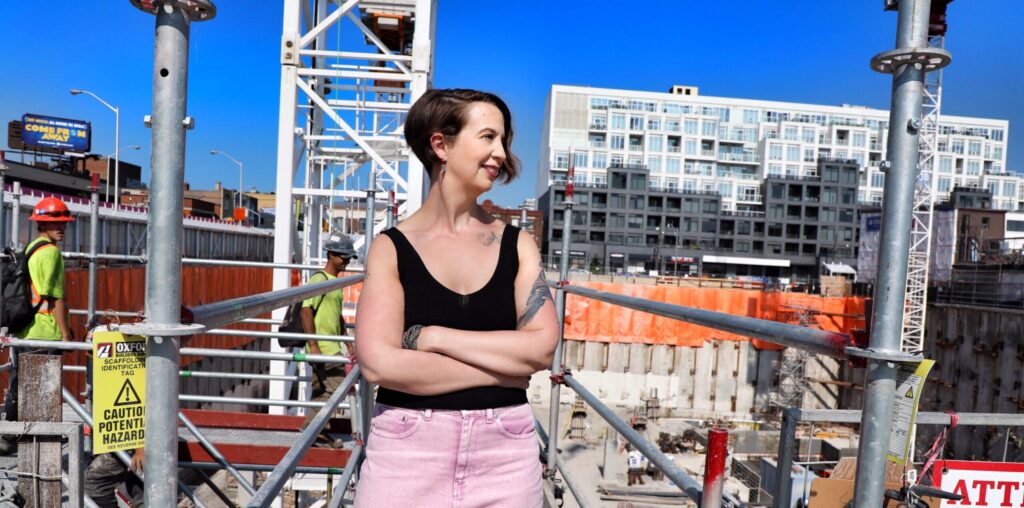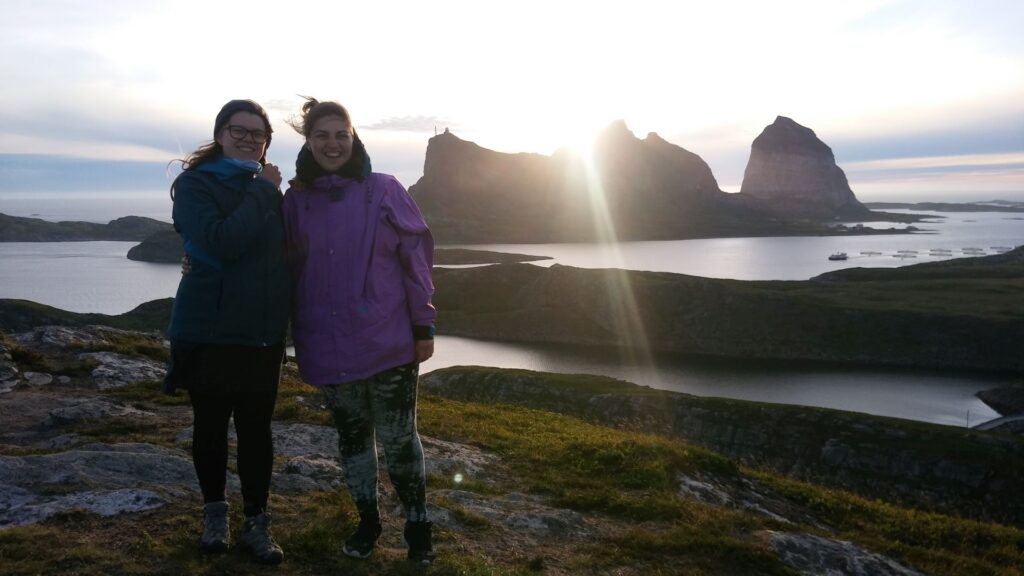Make Kin, not Cameras. Interview with Leslie Kern
In most cities, we rely on surveillance cameras and police to create safety. Leslie Kern counterargues that true urban safety comes from care: mixed-use spaces, community presence, and addressing root causes like poverty and mental health crises.
The author of Feminist City: Claiming Space in a Man-Made World was an associate professor of geography, environment, and women’s and gender studies at Mount Allison University in Canada before leaving academia to focus on writing, speaking, and coaching. We met in a gloomy classroom on a sunny afternoon during her final day in Tallinn, where she had come to give a lecture at the Estonian Academy of Arts.
You have a research background in gender studies and geography. How has your research and writing been shaped by your academic background, but also your personal life, for example, as a mother?
In my scholarly life I started out as a gender studies scholar, and I became a geographer by accident, because when I was doing my PhD I wrote about women as condominium owners in Toronto. Condos are like a form of apartment ownership, and there was a big boom. Women were buying all these condos, and I wanted to investigate what that was all about, so I had to delve into urban politics, urban development, gentrification, etc.
But at the same time, when I started my PhD, my daughter was very young. I was still trying to navigate urban environments as a mom with a very young child and finding that the spaces I once moved through so freely and felt so at home in were, if not hostile to me, then exclusionary. And so I had those questions in the back of my mind, like, who is the city for? How does the city let women down? What does the city promise us as women? And what barriers does it put up to us having full and flourishing lives?
Who is the city for? How does the city let women down? What does the city promise us as women? And what barriers does it put up to us having full and flourishing lives
In your book, Feminist City, your main claim is that cities have been mainly designed by men, built by men, for men. And to counteract that, you propose a set of feminist principles. But have you, over the years, seen any good examples of urban policy or design that genuinely integrate these feminist spatial concerns?
One recent intervention is in Bogotá, Colombia, where they’re tackling the question of care work in a really innovative way. They have come up with what they call ‘care blocks’. These are spatial areas in the city that concentrate care services in close proximity to one another, so that it’s easier to go to health appointments, laundry and communal kitchens all in one area. But they also provide care services, which means you can drop off children or others that you might be looking after. Then the women, who are usually the ones doing the care work, can have time to take computer classes, high school courses online, or have some leisure time for themselves.
What’s interesting is that they also have a ‘care school’ for men. There, men can learn how to cook and take care of the children, which are tasks that have traditionally fallen to women. The point is to involve men more actively in caregiving and reshape gender roles, not simply to reduce women’s workload. Other cities around the world are now in the early stages of trying their own version of the Bogotá care blocks.

The city of Bogotá in Colombia. Photo: Victor Rosario, Unsplash
Your approach to thinking is quite similar to what we call social design here in Estonia—the idea that the values, beliefs, and assumptions behind design are the most important elements to change first, which then transforms the design itself. Changing the ideas first creates innovation. What, in your view, is the easiest or most high-impact piece of unlearning for urban planners or policymakers?
One might be the idea that public space and the public — the people who use it — need to be controlled in some way. In North America, we often treat our public spaces in a harsh way. We sometimes have anti-loitering laws, or we discourage people from staying too long or from sitting, sleeping, socialising, gathering in groups in public spaces. Sometimes I think planning is oriented to ‘OK, how can we control what’s happening here, and how can we keep the people that we don’t want here out of these spaces’?
What can end up happening is that you have very monofunctional spaces — there’s only one use or one group of people who feels comfortable there, and everybody else feels excluded. Or you can have places that feel too watched or policed, whether literally by police or by security forces. I think planning can unlearn this to a certain extent and think about ways that people can determine from the bottom-up what they want their local spaces to be used for and in ways that would best serve their community. Rather than having somebody from the outside say ‘No, here’s where you can play football, sit for a picnic, or only stay for 20 minutes’.
In the Estonian Academy of Arts, they have a similar program you’re describing called SOFTacademy, where in the Mustamäe district they’re renovating grounds between the buildings using a bottom-up method. So the people who are actually living in these blocks of flats can decide what they want to do with their shared space, rather than have the city plan it. But relating to surveillance, you also argue that these safety problems cannot be fixed by surveillance alone. What design or governance practices have you seen that do better?
From a design and social-environment perspective, one of the things that tends to make people, including women, feel safe is when there’re multiple uses and multiple groups of people using space at different times of day and even into the night. That means getting away from what was once very central to modernist planning, where you would spatially separate zones of the city. You would have residential, green, institutional and commercial spaces all divided up by roads. These spaces tend to have ‘dead times’ when nobody’s using those spaces and people don’t feel safe moving through them.
Second, it’s not a very efficient use of space. Those areas could be for business during the day and for nightlife in the evening, or used by children at one time and teenagers at another. So having mixed-use spaces tends to create a greater sense of safety. Then the surveillance that you have isn’t from police or cameras or private security, but from the community of users who are there – the local businesses or people walking through the park. There’s a soft surveillance, if you will, what Jane Jacobs called ‘eyes on the street’ back in the 1960s.
Why do you think this belief that cameras are the best way to create safety is so strong? I once talked with a young politician here in Tallinn, and he was so proud of his project to install more and more cameras in their neighbourhood, believing that it would bring safety. Where does this thinking come from?
That’s a great question. My stance on it’s that in most cities we’ve overinvested in tools like policing and the criminal justice system to provide safety. But for the most part, these aren’t really prevention measures, they’re ‘can we catch somebody after the fact’ measures. They don’t necessarily make the city safer. You can have a lot of police, but they can’t be everywhere.
I think there’s this false idea that these blinking technological eyes will solve what are really more deeply rooted social problems. In some ways it’s easier to put up a bunch of cameras than it’s to make sure that people having a mental health crisis are receiving the treatment they need, so they aren’t acting in erratic ways on the street. Or to eliminate poverty, so that you don’t have people committing crimes to feed themselves or to access things. Those are deeper, more structural issues that are harder to tackle and maybe don’t win you a lot of votes. Whereas if you can say, ‘oh, look at all these cameras’, then maybe that seems like you are doing something, even though the root causes of danger and crime aren’t addressed at all.
In Foucauldian thinking, the camera changes how you act in space — for example, you know that somebody’s surveilling you and because of that you won’t commit the crime.
That’s the theory, but I don’t think there’s any research that has ever shown that to really be true in terms of whether we can actually say that cameras prevent crimes. Because one of the things that we know, even if you just watch reality TV, is that people get very used to the idea of cameras being around them and pretty quickly just start to act like their normal selves. In a world where there’re cameras everywhere all the time anyway, we’re conditioned to not pay attention to them. I think it’s a bit of a myth, or at least an overstatement of the case, to say that they change people’s behavior enough to stop them from committing crimes.
In most cities we’ve overinvested in tools like policing and the criminal justice system to provide safety.
You have written about how the desire for safer urban spaces for women, children, others, can end up pushing marginalised groups out of certain neighbourhoods. For example, there’s an effort to put in better lighting and reduce dark corners, but by addressing that, houseless people or people struggling with addiction no longer have a place to be, or they have been displaced — even though those were the only places available to them. Do you have any kind of recipe for solving this contradiction?
I do acknowledge that it’s a problem that people feel fear. It’s known that women adjust their behavior all the time to accommodate those senses of fear. But ultimately, from a bird’s-eye view, if you have more security cameras or bright lights everywhere, or people are forced to move on from a bus shelter they might be trying to rest in, then you have just moved that ‘problem’ somewhere else. It doesn’t actually help that person who is drinking or acting in a problematic way. Perhaps it even makes it worse, because it takes them out of what was a safe context for them — an area where they could access services, shelter, or get a hot meal a couple of times a day. And if, through gentrification or other security measures, people are pushed away, then their problems are likely to become worse. You aren’t going to create long-term safety for anybody just by engaging in these band-aids or short-term solutions of moving people out of your sight.

Photo: Levi Meir Clancy, Unsplash
We can move on to Tallinn and its problems and beauties. Cars and urban safety are one of the hot topics at the moment in Estonia. For example, this summer a 26-year-old woman was killed by a bus right in the city center, while at the same time in Helsinki there were no traffic fatalities last year. It’s a polarising topic here. In this year’s local elections the claim that the car owners are being bullied was the main selling point for some parties. How might a feminist approach help reframe this conversation around mobility and safety?
In most places around the world, women are more likely to use public transportation or walking instead of cars as their primary mode of mobility. In families where there’s one car, it’s more likely that the man of the house has regular access to that car. There’re gender differences in people’s forms of mobility. Women also do more care-related journeys, where they’re more likely to make stops along the way. Having a very good and frequently running transportation system really helps with that care work, whereas men are more likely to commute in and out without making all of those additional stops.
It’s also the case that when it comes to traffic accidents, especially those involving pedestrians, women are at greater risk of being fatally injured by cars because of height and smaller body size. Children and elderly people are also at greater risk.
We also have quite a big crisis with men’s mental health, and somehow these cars feel quite personal spaces for a lot of men. This is reflected in the discussion about car usage. It feels personal for some when you aren’t allowed to drive your car to a place, or it’s said that now you can only drive 30 km/h here. In Estonia, people have had the possibility to have their own car for only about 30 years, as cars were very difficult to acquire during the Soviet period. Now these machines have become a big pride of theirs. How do we manage this tension?
I think you have hit on something important, and I don’t think it’s unique to Estonia. Certainly a lot of advertising of cars is targeted at men and really tries to tie together masculine identity and car ownership. You see these themes of ‘cars equal freedom,’ ‘cars equal status in society,’ or ‘the nicer your car, the higher your status.’ Cars are associated with independence and self-sufficiency. And these things, as values, tend to skew masculine in many cultures.
I think there’s a cultural piece to this as well that you are hinting at – that there needs to be a shift perhaps in the meaning behind car ownership. Maybe there’s something to be said then for how we market public transportation. How do we sell public transportation, cycling, or walking to men in a different way that would actually satisfy some of these needs that they have or that they have been socialised into having?

The port of Noblessner in Tallinn. Photo: Denis Shlenduhhov, Unsplash
Another big problem we’ve here in Tallinn is segregation. Geographer Tiit Tammaru wrote in 2019 that Tallinn is Europe’s fastest segregating capital in terms of socio-economic and ethnic residential patterns. Speaking in binary terms, there’re now neighbourhoods where there’re mostly Russian-speaking, poorer populations, and then these fancy big neighbourhoods where Estonian-speaking, richer people are. How can this intensifying segregation in Tallinn – or similar cities – complicate, or deepen the challenges of feminist urban planning and anti-gentrification?
When we create a scenario where some people have really good access to the fastest form of public transportation, they’re living close to all kinds of services they need – their place of employment or their kids’ schools – then those people tend to forget that in outlying neighbourhoods, people don’t have all of this. They’re waiting for the bus rather than a speedy tram to take them where they want to go. Or it takes them two or three different connections to get into the central city or the areas where they work. It intensifies segregation, because you have then people who are like, ‘Well, everything’s fine! We don’t need to pay more attention to public transportation,’ or ‘We don’t need to invest more in social housing, and schools here are fine.’ And you forget about or leave behind those other places, rather than seeing this as a collective, city-wide effort where we want to lift everybody up and make sure that everybody has good schools, nice green space, safe streets to walk on, nice bike routes, and good, fast public transportation.
We’ve talked a lot about the feminist city from a physical world perspective. When I mentioned to one of your readers, who is in her mid-twenties, that I was meeting you, she said that she was very inspired by the concept of the city of friends when reading your book. In other words, how practicing female relationships as a way of life is a world-making activity. As an ending thought: if we, or the reader, don’t have the power to have a great impact on the general city planning, how can we still be feminist world-makers?
That’s a beautiful question and I will just pick up from the way that you asked it. I think one of the feminist world-making approaches can be about the kinds of relationships and kinships we value and prioritise. Also, thinking about alternative forms of kinship that aren’t centered around monogamous romantic relationships as the most important relationships that we can have and which we structure our personal and economic systems, our families, and household forms around.
If we broaden that and think about whether it’s friendships, neighbourliness, wider community, intergenerational relationships, relationships with nature, and the non-human world as well – think about all of those existing in a non-hierarchical web – then I think we can more easily imagine how we can support our neighbours. Instead of seeing neighbours as a secondary relationship, we could think, actually, it would be quite important to clear the snow from my neighbour’s sidewalk or to bring a cup of tea over to an elderly person who lives down the hall in that 13-story apartment building. If we can think on an individual level how to reprioritise or to multiply prioritise different relationships in our life, then we can start to dismantle some of the—lets face it—quite patriarchal ways of setting up a family and interpersonal relationships that we’ve inherited over hundreds or thousands of years.









